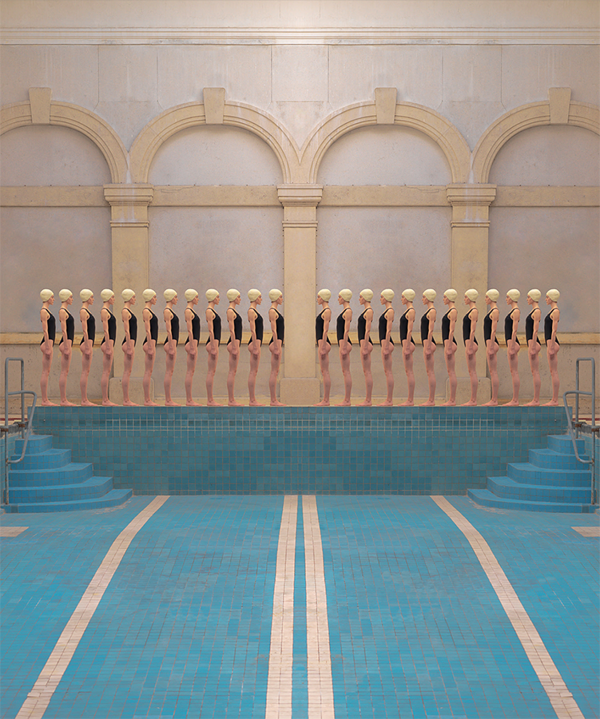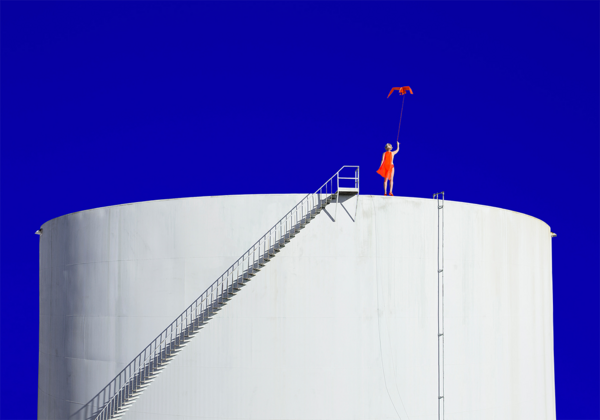Reine Paradis, L’Envol from Jungle, 2018. ULTIMATE Photographs London.
Whether the first or the last, a one-off or the only one available, each work in Phillips' ULTIMATE collection is on offer exclusively in our 19 May London Photographs auction. To kick off the latest iteration, we invited three of our featured artists to talk about the inspirations and processes behind their remarkable photographs.
Reine Paradis
PHILLIPS: What is the idea behind the title of your work?
REINE PARADIS: The title reflects the essence of this image. Quite literally, when translated into English, L’Envol means "To take off."
P: Is it related to any themes that continue to emerge in your practice?
RP: Each scene I create is part of a journey through a world of my creation. It borders reality and pure imagination — a place where anything is possible.
P: How were you thinking about color in this work?
RP: I have always been drawn to intense colors. In the series Jungle I chose to use a vibrant blue for any natural elements, including the sky, water, and grass. Afterwards, I interspersed orange, its complimentary color, to highlight that everything in the image belongs to the illusory world that I have created. Color is one of the most important aspects of my work.
P: What feelings does the work evoke for you?
RP: We all perceive art and the world around us very differently. I love that everyone sees my work in their own way, so I prefer not to impress anything on the viewer.
P: What was the process of creation like for this work?
RP: I use the same process for all my works. I start by imagining the scene and then create a maquette using acrylic and pen that will act as a reference throughout the entire process. After this initial stage, I go on to design the props, costumes, and origami figures. Once this preparation is complete, we shoot the scene on location. As the scenes are all imagined and sketched prior to shooting, it is often a challenge to find suitable locations. I spend a lot of time scouting before I settle on the perfect setting, but the process is always an adventure.
Byung-Hun Min

Byung-Hun Min, MG247, 2010. ULTIMATE Photographs London.
PHILLIPS: What is the idea behind the title of your work?
BYUNG-HUN MIN: I wanted to find an impromptu and spontaneous way to title my series without giving the viewer any preconceptions by using a descriptive title. I have used the same approach for several other of my series. For example, I use the initials MG to title the Mankind series, WV is for the Weed series, DF is for my Deep Fog series, and FF for the Waterfall series.
P: Is it related to any themes that continue to emerge in your practice?
BHM: Throughout my photographic career of over 40 years, I have always found exploring my inner world to be more interesting than focusing on subject matter. I aim to fully express my emotions through the camera’s lens. My photographs are primarily gelatin silver prints with low contrast and subtle tones achieved through gentle exposure in the dark room.
P: What feelings does the work evoke for you?
BHM: In an age where the essence of photography has become ambiguous, I remain fascinated by it. To me the meaning of photography lies in its relationship to reality which is something I learned in the late 1970s and early 1980s.
P: How were you thinking about color in this work?
BHM: While working in black and white, I try and express the essence of the colors that I see, layering in my emotions. I am particularly captivated by textures and details that become more vivid under low light caused by heavy rain, mystifying fog, or fresh snow.
P: What was the process of creation like for this work?
BHM: All the male and female models photographed in my nude series are ordinary people that I encounter every day, not professional models. They willingly participated in my work, allowing for much closer communication than with formal models. Rather than seeking special poses, I aim to capture their natural feelings in a calm and faithful manner, just as I do with my nature photographs, and then reproduce them in the final printing process.
Maria Svarbova

Maria Svarbova, Grössling City Bath, 2020. ULTIMATE Photographs London.
PHILLIPS: What is the idea behind the title of your work?
MARIA SVARBOVA: During the revival of the iconic Grössling City Bath, the Metropolitan Institute of Bratislava approached me to document the baths in their former state through my artistic lens. Personally, I look for more modern architecture for my projects with a focus on functionalism and brutalism. Taking photographs in the classical structure of the Grössling bath was a challenge for me, but after receiving a tour of the building, the potential became clear.
P: Is there a conceptual or spiritual intent in the work? Is it related to any themes that continue to emerge in your practice?
MS: I try to create harmony between my chosen space and the human beings that occupy it without one dominating the other. While I love nature and being in nature, I seek out places that were built by man for my work.
P: How were you thinking about color or tone in this work?
MS: I started my Swimming Pool series by contrasting delicate pastel colors with vibrant reds and yellows that complement the neutral hues of the blue pool and white tiles. Recently, I have chosen a subdued color palette with a darker composition. This is especially true for my works in 2020 and the effect can be almost monochromatic.
P: What thoughts or feelings does the work evoke for you?
MS: I prefer minimalism and symmetry, using pure lines and large open spaces with lots of daylight consistently in my practice. Working with open, airy spaces is an important factor in my creative process and creates a timeless sense of freedom within my photographs.
P: What was the process of creation like for this work?
MS: I rely on my visual imagination. I can see in advance how the final image is supposed to look while leaving room for chance even when shooting on location. Organization and communication are naturally very important when undertaking a project. I put my team together myself, working closely with set designers, costume designers, stylists, models, producers, and location scouts. Depending on the series, the results can materialize quite quickly. I am very detail-orientated and expect a lot from people. I like to think that I am a fast photographer with a clear vision. There are moments when I fear that the scene will magically evaporate, so I take a lot of pictures very fast to capture it. First and foremost, I believe a photograph needs to look good in the viewfinder of the camera. Post-production editing is just the cherry on top.
Discover More from Photographs London >
Recommended Reading
